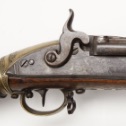Big bore PCP airguns are a new thing, right? You really couldn’t be more wrong! When folks find out that airguns have been a major part of military history for centuries, they often look like deer in the headlights. The most iconic big bore PCP airgun has to be the Girandoni air rifle.
Never heard of it? Well, have you heard of the Lewis and Clark expedition? They carried the Girandoni with them and it became known as the Lewis and Clark air rifle, saving their lives in more ways than one. Let’s take a look at this historic airgun.
A little history lesson.
PCP airguns have been around for a very long time. It all depends on who you talk to, but some historians put the “official” date in the 1500s, while some may argue that airguns existed back into the 1400s. Regardless of the date, we are talking about hundreds of years. These airguns were used for hunting, assassinations, and even as military weaponry. They held many advantages, the greatest of which was the lack of a powder plume to give away their position.

Design of the Girandoni Rifle
The Girandoni air rifle dates back to the late 1700s and was used by the Austrian military. It held a great advantage as it was a repeating rifle. While your enemy may have gunpowder, they had to take a lot of time to reload before you could take another shot.
The rifle had some impressive specs. It was about 4 feet long, weighed in at about 10 pounds. The Girandoni had a tubular magazine that held 20 rounds. These .46 (or .51 as there were at least two variations) caliber round balls could be fired at velocities up to 500 FPS, generating up to 117 foot-pounds. While that’s not a lot of energy by today’s standards, it highlights the fact that you don’t need a lot of energy to be lethal. The effective range was about 125 yards on a full cylinder, decreasing as pressure dropped in the cylinder.
Each rifle came with a hand pump to fill the air reservoir, which was the rifle’s buttstock. The rifle was capable of 30 shots from the cylinder. Soldiers would need to hand pump the cylinders to have them ready for battle and were issued three cylinders and 100 rounds. The accessories were stored in leather packs carried by the soldiers. Unlike modern-day PCP hand-pumps, each cylinder could take up to 1500 strokes to fill.
It all sounds rather awesome when considering the other options available. Multi-shot, long-range accuracy, high shot count, on paper that’s huge, but there were some significant disadvantages, primarily due to the high cost and problematic manufacturing practices at the time. The cylinders were manufactured from hammered steel and connected by rivets. They were sealed by brazing which often leaked, rendering the weapon useless. When it worked, it was an effective and lethal tool. When it didn’t, it left the owner defenseless.
How the Girandoni Impacted American History
When Lewis and Clark set out on their journey, they needed a way to defend themselves and feed themselves. While they certainly had firearms, they had many limitations and required more supplies to operate. The Girandoni offered a unique solution to the problem. Since it only needed round ball ammo and elbow grease to operate, it saved space and increased operational utility because it was a repeater.
Stories vary, but some accounts state that Lewis and Clark leveraged the multi-shot capability as a way to create a mystique about their superior firepower. By shooting several shots, but never so many as to run out, the natives thought they had unlimited ammo and a way to deliver it. It’s also reported that Lewis and Clark never allowed anyone to view the filling process for the same reason.
In a world where each follow-up shot was another 40 to 60 seconds away, can you imagine seeing 10 to 15 shots buried into the side of a tree before another person could get off a second shot?
We may never know all the ways in which the Girandoni was actually used but what we do know is that it was a critical element to the success of their expedition. You can see a wonderful Girandoni replica along with other period-specific PCP airguns from history in the Daisy Museum in Rogers, Arkansas. If you ever get out that way, be sure to swing by and see what other airguns, and airgun companies, impacted our American history.
